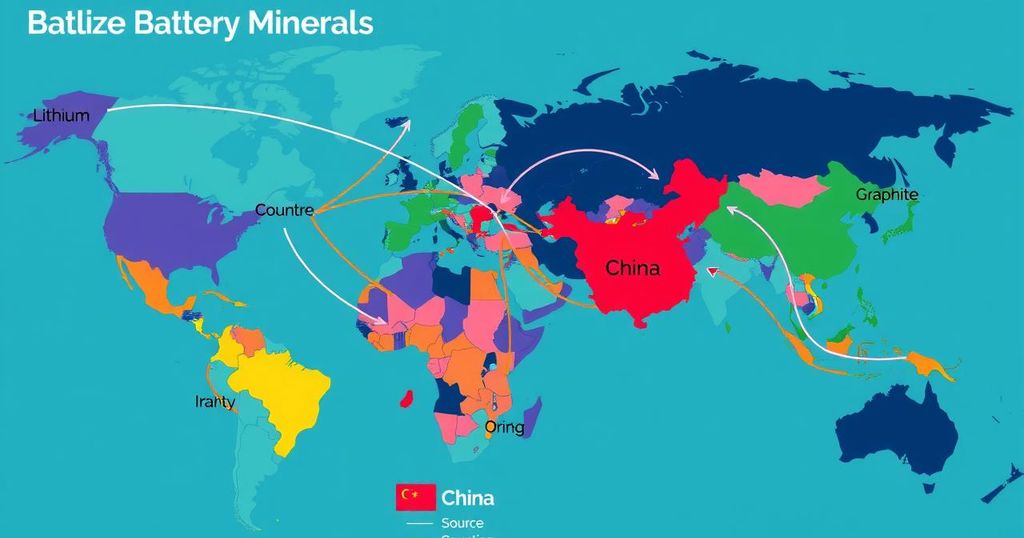China’s Unyielding Dominance in Global Battery Minerals Trade

China commands a substantial share of the global battery minerals market, importing 44% and exporting 58% of battery materials in 2023. With control over significant production rates of lithium, graphite, and cobalt, China’s impact on the energy technology sector is profound as demand grows.
China’s strong influence on the global battery supply chain is evident, as it continues to dominate trade in essential battery minerals. In 2023, China reportedly imported nearly 12 million short tons of both raw and processed battery minerals. This figure accounted for approximately 44% of the worldwide interregional trade of these critical resources. Moreover, the export of battery materials and related components reached nearly 11 million short tons, comprising a substantial 58% of interregional trade, as noted by the United Nations Comtrade data.
The focus here lies on three key battery minerals, namely graphite, lithium, and cobalt. These minerals are either mined from natural sources or synthetically produced. Following their extraction, they are transformed into battery materials, leading to heightened trade driven by surging demand in electric vehicles and renewable energy technologies. As this demand grows, the significance of these minerals increases dramatically.
When examining the production and trade of these battery minerals, lithium stands out as it is mainly obtained through brine extraction or hard rock mining. Cobalt production largely occurs as a byproduct of nickel and copper mining, while graphite can be mined naturally or produced synthetically. In 2023, Chinese sources dominated lithium production, contributing around 18% of the global mined lithium output, alongside a 25% stake in worldwide lithium mining capacity.
According to the National Geospatial-Intelligence Agency’s Tearline Project, China’s investments in Argentina’s lithium triangle—which encompasses Argentina, Bolivia, and Chile—enable it to tap into 50% of the world’s lithium reserves. Additionally, in 2024, China produced about 79% of the global natural graphite supply, while the U.S. produced none. Should there be any questions about cobalt, it’s important to note that Chinese firms control approximately 80% of Congo-Kinshasa’s cobalt production.
China’s dominance extends to the shipping of these minerals. The country was responsible for 46% of global raw battery mineral imports in 2023, with Australia being a primary supplier. Almost all of Australia’s lithium exports were directed to China, emphasizing the close economic ties. Together, Australia, China, and the wider Asian and Oceanian region comprised 71% of raw battery mineral import trade for the year.
Processing and refining is another area where China leads; it handles over 90% of the global graphite processing. In 2022, Chinese entities controlled more than two-thirds of the world’s processing capacity for lithium and cobalt as well. Statistics show that, in 2023, China imported around 20% of processed battery minerals, chiefly cobalt, from Africa. On the other hand, during the same year, China exported 58% of processed battery minerals, mainly synthetic graphite, going mostly to Asia and Oceania.
As for manufacturing, processed minerals are crucial for creating battery materials tailored to different battery types. In 2023, China was responsible for 53% of worldwide battery material exports. These materials are then integral in assembling components like electrodes and electrolytes. Notably, in 2022, Chinese manufacturers produced 85% of the global anodes, 82% of electrolytes, 74% of separators, and a whopping 70% of cathodes.
Furthermore, China accounted for a substantial 74% of the global trade in battery packs and components in 2023, while maintaining control over 85% of global battery cell production capacity by value. Overall, the latter figures underline China’s sheer magnitude in terms of industry influence and future potential in the battery minerals market.
In conclusion, China’s grip on the battery minerals market is increasingly undeniable, spanning from raw material extraction to advanced processing and manufacturing. With its dominance in mining, refining, and exporting, China is poised to shape the future landscape of the global battery industry significantly. Policymaking and international trade relations could see profound impacts as demand for these battery minerals continues to escalate, further solidifying China’s position in a critical global sector.
In conclusion, China significantly dominates all aspects of the battery minerals supply chain, from extraction to processing, and ultimately, manufacturing components and materials for batteries. As global dependence on electric vehicles and renewable technologies rises, China’s leading role in lithium, graphite, and cobalt production and trade is likely to intensify, influencing the future dynamics of the battery market worldwide.
Original Source: batteriesnews.com







